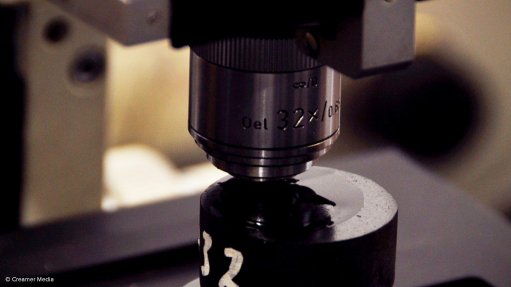
EXTENDED OFFERING Bureau Veritas has seen a steady increase in demand for its analytical services since 2013 owing to its extended service offerings
Testing, inspection and certification company Bureau Veritas’ expanded scope of petrographic and analytical offerings has increased demand for specialised testing solutions.
Bureau Veritas petrography specialist Willem Swanepoel tells Mining Weekly that the company’s service expansion strategy began in 2012. He states that – owing to its service expansions – the company can now boast that all South Africa’s coal mining establishments and even some of its in-house analytical service providers rely on Bureau Veritas for specialised testing and quality certifications. He says the company noted an increase in demand in 2013, despite a halt in coal industry growth.
Coal mines in South Africa “have been affected by low investment” over the past three years; subsequently developments of new projects and exploration have decreased.
“The coal industry is a challenging space mainly because there has not been significant growth in coal projects, which has resulted in low demand for value-add analytical services,” Swanepoel laments. He adds that explorative analytical service providers, such as Bureau Veritas, are invariably the “hardest hit” by market slowdowns and when mines want to reduce their capital investments.
However, Swanepoel qualifies that Bureau Veritas’ coal division has managed to remain relevant and profitable by providing an expanded scope of coking coal and coal analytical services. Bureau Veritas runs an end-to-end process where it provides exploration services, on-site testing and independent third-party certifications of the quality and quantity of a mine’s coal products intended for export.
“In the past, Bureau Veritas offered petrography services only to the coal industry but, over the past three years, the company also added more specialised forms of petrographic analysis, such as anthracite analysis, abnormal condition analysis and coke petrography.”
Petrography 101
Petrography is the microscopic investigation of coal products to determine their maturity and type.
Swanepoel states that this process is pivotal in determining the quality, use and potential pricing of any coal-based product. Bureau Veritas can classify coal as low, medium or high rank by determining a coal sample’s reflectance percentage. As reflectance increases, volatility decreases and carbon content increases, which indicates a more mature coal, he stipulates.
The petrographic process can be used to identify the potential best use of coal supplies, with coal samples categorised according to their reflectance, morphology, colour, texture and structure. The process can also be useful in detecting coal contamination, determining the number of coals in a blend sample and identifying abnormalities, which may effect its performance and quality.
“Different types of coal have different properties, which cause them to behave differently when exposed to high temperatures in boilers or ovens. This makes them useful for different burning processes.”
Swanepoel adds that petrographic analytical services are often in the best interest of buyers and sellers of coal products, as the testing provides both parties with a firmer understanding of the use and quality of the coal prior to sale.